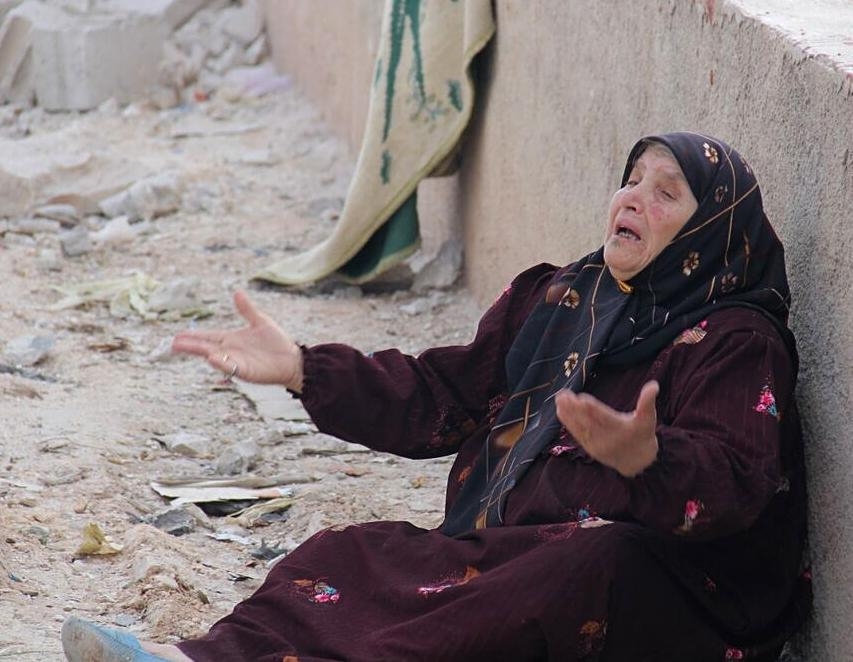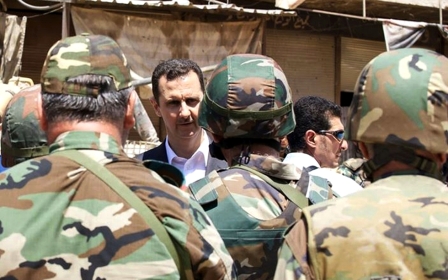War on Islamic State: A New Cold War fiction

Russia is bombing “terrorists” in Syria, and the US is understandably peeved.
A day after the bombing began, Obama’s Defence Secretary Ashton Carter complained that most Russian strikes “were in areas where there were probably not ISIL (IS) forces”.
Anonymously, US officials accused Russia of deliberately targeting CIA-sponsored “moderate” rebels to shore-up the regime of Bashir al-Assad.
Only two of Russia’s 57 airstrikes have hit ISIS, opined Turkish Prime Minister Ahmet Davutoglu in similar fashion. The rest have hit “the moderate opposition, the only forces fighting ISIS in Syria,” he said.
Such claims have been dutifully parroted across the Western press with little scrutiny, bar the odd US media watchdog.
But who are these moderate rebels, really?
Moderate al-Qaeda
The first Russian airstrikes hit the rebel-held town of Talbisah north of Homs City, home to al-Qaeda’s official Syrian arm, Jabhat al-Nusra, and the pro-al-Qaeda Ahrar al-Sham, among other local rebel groups. Both al-Nusra and the Islamic State have claimed responsibility for vehicle-borne IEDs (VBIEDs) in Homs City, which is 12 kilometers south of Talbisah.
The Institute for the Study of War (ISW) reports that as part of “US and Turkish efforts to establish an ISIS ‘free zone’ in the northern Aleppo countryside,” al-Nusra “withdrew from the border and reportedly reinforced positions in this rebel-held pocket north of Homs city”.
In other words, the US and Turkey are actively sponsoring “moderate” Syrian rebels in the form of al-Qaeda, which Washington DC-based risk analysis firm Valen Globals forecasts will be “a bigger threat to global security” than IS in coming years.
Last October, Vice President Joe Biden conceded that there is “no moderate middle” among the Syrian opposition. Turkey and the Gulf powers armed and funded “anyone who would fight against Assad,” including “al-Nusra,” “al-Qaeda in Iraq (AQI),” and the “extremist elements of jihadis who were coming from other parts of the world”.
This external funding enabled Islamist factions to systematically displace secular Free Syria Army (FSA) leaders, culminating in the rise of IS.
In other words, the CIA-backed rebels targeted by Russia are not moderates. They represent the same melting pot of al-Qaeda affiliated networks that spawned the Islamic State in the first place.
Our Islamists
And they rose to power in Syria not in spite, but because of the US rubber-stamping the jihadist funnel through the so-called “vetting” process. This summer, for instance, al-Qaeda led rebels received accelerated weapons shipments in a US-backed operation to retake Idlib province from Assad.
Notice here that the US priority was to rollback Assad’s forces from Idlib - not fight IS. Yet the brave Western press, so outspoken on Russian duplicity, somehow overlooked how this anti-ISIS coalition operation failed to target a single IS fighter.
Since Russia’s intervention, the press has been particularly coy about the fact that Washington’s “moderate” rebels include the likes of al-Nusra, Ahrar al-Sham and the Islamic Front.
While al-Nusra, of course, is al-Qaeda’s Syrian branch, Ahrar al-Sham openly “cooperates with the Syrian affiliate of al-Qaeda and has welcomed former associates of Osama bin Laden” according to the New York Times. “While its leaders say they seek to create a representative government, they avoid the word ‘democracy’ and say Islam must guide any eventual state.”
The Islamic Front, Syria’s largest opposition grouping consisting of tens of thousands of fighters, aims to establish an “Islamic state” in Syria, rejects democracy and secularism, and welcomes al-Qaeda foreign fighters as “brothers who came to help us”.
Islamic Front leader Zahran Alloush is on record as having praised Osama bin Laden, endorsed cooperation with al-Nusra, and repeatedly called for the total extermination of Shia and Alawite communities in the Levant.
These are the “moderates” the US has empowered in the name of fighting IS.
How not to vet rebels and influence people
The US has evaded formal responsibility for doing so using the best covert operation traditions: plausible deniability by passing the buck.
Since 2012, the CIA-run clandestine rebel-vetting programme has been conducted outside Syria, in partner countries like Saudi Arabia, Qatar, Jordan and Turkey. Although CIA and US military personnel oversee the programme, they “vet” rebels largely through ‘intelligence’ provided by its own allies.
The supposedly rigorous vetting process includes “psychological exams,” gathering of “biometric data,” and running the names of candidates “through US databases” and “with regional allies for checks”.
Recruits already known to the US government are checked easily based on internal data. But for new recruits, the US depends on the “expertise” of its coalition partners like Saudi Arabia and Turkey.
Still, CIA personnel were “helping allies decide which Syrian opposition fighters” would receive arms. But the relationship between the “moderate” FSA and the jihadist factions, including IS, had grown increasingly porous.
German journalist Jurgen Todenhofer, who spent 10 days inside the Islamic State, reported last year that IS militants are being “indirectly” armed by the West: “They buy the weapons that we give to the Free Syrian Army, so they get Western weapons - they get French weapons… I saw German weapons, I saw American weapons.”
The CIA knew what was happening: classified intelligence assessments year after year showed that most Saudi, Turkish and Qatari arms ended up with “hard-line Islamic jihadists, and not the more secular opposition groups”.
The CIA programme has not been shut down, although it has predictably failed to arm moderates despite seeding nearly 10,000 rebel fighters - many of whom have joined the IS terrorists the West is supposed to be fighting.
Instead, the Pentagon has been tasked to establish a “new,” separate, “moderate” rebel-training programme.
Unsurprisingly, that programme has virtually collapsed, even as the CIA continues to arm the jihadists that pretend to hate IS while cooperating with IS to fight Assad.
Just last month, in extraordinary testimony before the Senate Armed Services Committee, General Lloyd Austin who leads the anti-ISIS strategy at US Central Command admitted that there are only “four or five” US-trained “moderate” rebels in Syria currently fighting IS.
Who is fighting IS, really?
This doesn’t mean questions about Russia’s strategy are unjustified. Clearly, Vladimir Putin’s self-serving intervention in Syria is about keeping the brutal Assad in power, by crushing the rebel forces seeking his removal.
But Western journalists obediently mimicking the State Department line have universally failed to ask the sort of questions they rightly ask of Russia: namely, why is the US-led coalition refusing to bomb Islamic State extraction wells and oil truck convoys?
A sobering Greenwich University study published by Maritime Security Review in March on the Islamic State’s illicit oil trafficking networks comes to some surprising conclusions on this issue.
Authored by George Kiourktsoglou, lecturer in maritime security and former Royal Dutch Shell strategist, and Dr Alec Coutroubis, acting head at the Faculty of Engineering and Science, the study finds that US, Turkish and Gulf air raids on ISIS “oil manufacturing facilities” have not gone far enough: “Extraction wells in the area of bombardments have yet to be targeted by the US or the air-assets of its allies, a fact that can be readily attributed to the at times ‘toxic’ politics in the Middle East.”
The scholars, who have previously given evidence before the UK Parliamentary Foreign Affairs Select Committee, further report that despite large convoys transporting IS oil through Syria, Iraq and Turkey, “allied US air-raids do not target the truck lorries out of fear of provoking a backlash from locals” (although killing up to a thousand Syrian civilians is apparently fine). As a result, “the transport operations are being run efficiently, taking place most of times in broad daylight”.
So the US is not targeting the Islamic State’s financial lifeline - its black market oil infrastructure - but instead is teaming up with the same al-Qaeda affiliated groups that spawned IS in the first place, to undermine Assad. And Russia, for all its muscle-flexing rhetoric, sees its main priority as countering US-led efforts to topple Assad, by targeting his most immediate opponents.
This is, in other words, a New Cold War between competing empires, the unending victims of which are the Syrian people. As for the Islamic State, it is little more than the proxy bastard child of a conflict that looks set to escalate.
- Nafeez Ahmed PhD is an investigative journalist, international security scholar and bestselling author who tracks what he calls the 'crisis of civilization.' He is a winner of the Project Censored Award for Outstanding Investigative Journalism for his Guardian reporting on the intersection of global ecological, energy and economic crises with regional geopolitics and conflicts. He has also written for The Independent, Sydney Morning Herald, The Age, The Scotsman, Foreign Policy, The Atlantic, Quartz, Prospect, New Statesman, Le Monde diplomatique, New Internationalist. His work on the root causes and covert operations linked to international terrorism officially contributed to the 9/11 Commission and the 7/7 Coroner’s Inquest.
The views expressed in this article belong to the author and do not necessarily reflect the editorial policy of Middle East Eye.
Photo: A Syrian woman reacts after her home were damaged by the Russian air strikes in Maasaran town, Idlib, Syria on 7 October, 2015
New MEE newsletter: Jerusalem Dispatch
Sign up to get the latest insights and analysis on Israel-Palestine, alongside Turkey Unpacked and other MEE newsletters
Middle East Eye delivers independent and unrivalled coverage and analysis of the Middle East, North Africa and beyond. To learn more about republishing this content and the associated fees, please fill out this form. More about MEE can be found here.





